ASM Metals HandBook Vol. 17 - Nondestructive Evaluation and Quality Control
Подождите немного. Документ загружается.

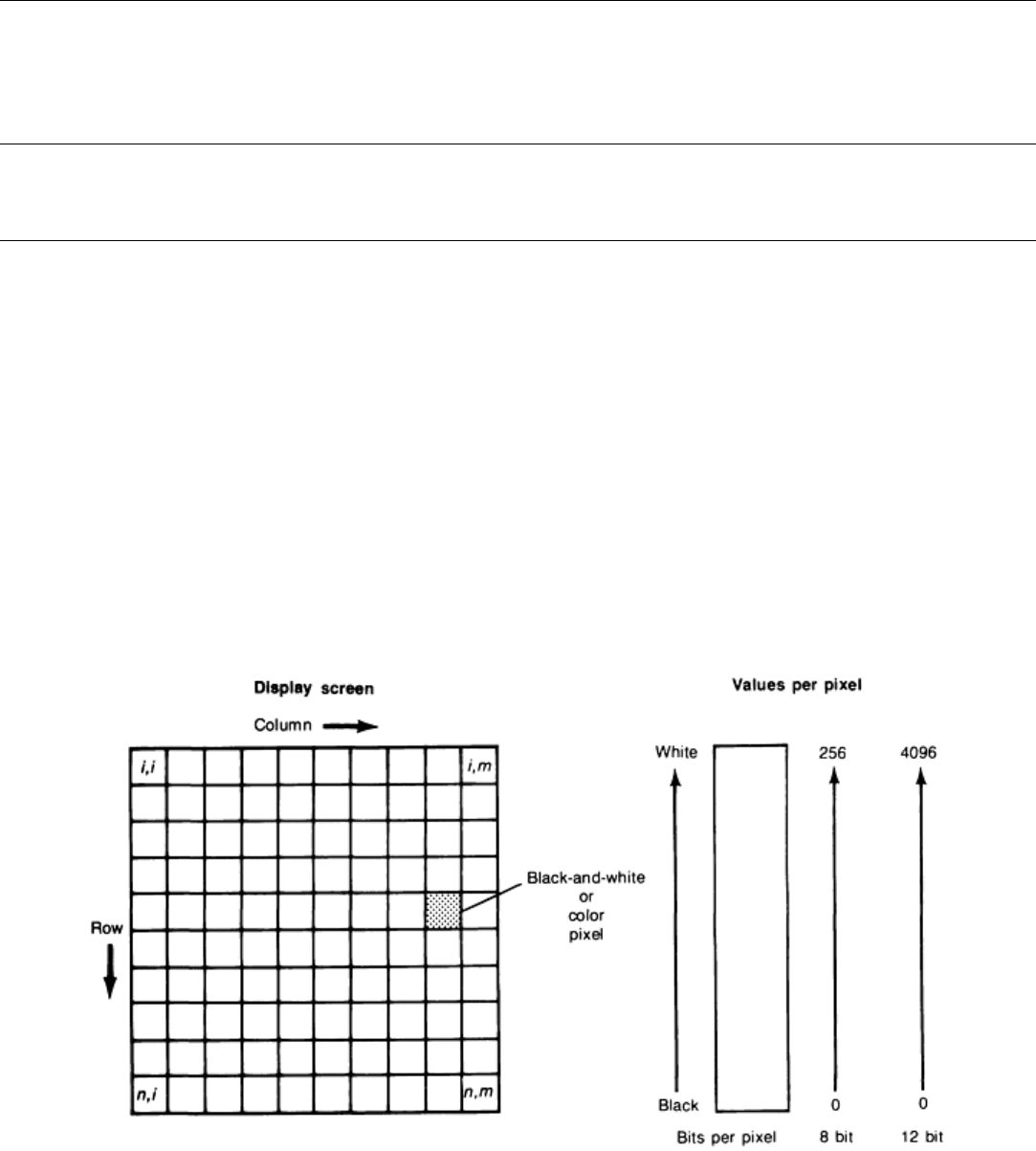
(d)
Typical performance
Reference cited in this section
11.
J.J. Dongarra, "Performance of Various Computers Using Standard Linear Equations Software in
a Fortran
Environment," Technical Memorandum 23, Argonne National Laboratory, 1989
Digital Image Enhancement
T.N. Claytor and M.H. Jones, Los Alamos National Laboratory
Image Capture and Acquisition System
An important part of image enhancement is the system that captures or acquires the data. In many cases, an image will be
recorded on film to be digitized, or the data will come directly from an inherently digital system, such as real-time
radiography, thermographic, or ultrasonic imaging system. The quality and dynamic range of the image will influence
subsequent processing. It is usually desirable to have interscene dynamic ranges greater than 6 bits (64 levels). The eye
has a dynamic range of about 10
10
(photopic and scotopic combined), an interscene dynamic range of about 150, and a
brightness discrimination of 2% (50 levels) (Ref 3). The schematic of a typical display system is shown in Fig. 2. Each
pixel can represent a gray level or color, and if the pixel is composed of 8 bits, 256 gray shades or colors can be
displayed. Because the eye has an approximate dynamic range of 150, a 256-level display is adequate for gray-level
viewing. For computational purposes, for the display of color, and for the ability to fully digitize film, it is sometimes
desirable to have a 12 (or more) bit pixel, which can be compressed into 8 bits for display. The display size indicated in
Fig. 2 is N × N; for most systems, N should be at least 512, with 1024 preferred.
Fig. 2 Concept of image display (a) and representation (b) in computer memory
Table 2 lists several types of digitizers that are currently available. Although charge-coupled device (CCD) cameras and
light tables are the standard for the efficient input of medium-resolution optical data, there are other alternatives better

suited to specific applications. The vidicons offer the highest frame rates in formats of 1024
2
and more, the line scanners
have excellent resolution at moderate prices, and the micro-densitometers are the most precise with regard to photometric
and geometric quantities. Most microdensitometers will digitize to 12 bits, which limits their dynamic range to about 3.6
in film density. As noted in Table 2, the standard scanning microdensitometer (row one) will take longer (up to several
hours) to scan film if the film density is over 2. The laser scanners are faster (depending on the make) because of the more
intense laser light source and the fact that one axis is scanned with the light beam rather than mechanically.
Table 2 Typical characteristics of image digitization devices
Face plate
illumination
Type Image
quality
Pixel size or
pixel number
resolution
Acquisition
time per
1024
2
by 8-bit
image
Interscene
dynamic
range
Image
area, mm
× mm
(in. × in.)
lx
ftc
Microdensitometer Excellent
5-75 m (200
in.-0.0030 in.)
(a)
15 min
4096
500 × 500
(20 × 20)
. . .
. . .
Point source
and detector
Laser scanner Excellent
35 or 75 m
(0.0014 or 0.0030
in.)
(a)
1 min
4096
430 × 350
(17 × 14)
. . .
. . .
Linear CCD array Good
4096
500 ms
>1500 . . . . . .
. . .
Linear detector
Photodiode array Good
1024
5 s
1000 . . . . . .
. . .
CCD Fair 1320 × 1035
140 ms
500 . . . 1.5
0.14
Solid-state
cameras
CID Fair 776 × 512 33 ms
(b)
200 . . . 0.1
0.009
Vidicon (Sb
2
S
3
) Fair >1500 33 ms, lag =
20%
80-200 . . . 5
0.5
Newvicon (ZnSe) Fair 800 33 ms, lag =
10-20%
50-200 . . . 0.5
0.05
Pasecon/Chalnicon
(CdSe)
Fair 1600 33 ms, lag = 5-
10%
30-60 . . . 1
0.09
Saticon (Se+Te+As) Fair 1200 33 ms, lag =
3%
50-160 . . . 6
0.6
Plumbicon (PbO) Fair 1200 33 ms, lag =
4%
80-160 . . . 2.5
0.23
Tube type
cameras
(vidicon family)
SIT (Silicon) Fair 750 33 ms, lag =
7%
60 . . . 0.01
0.0009

(a)
Aperture.
(b)
776 × 512
Linear CCD or photodiode arrays are good choices for film digitization and can have even better dynamic ranges than
those listed in Table 2. When these devices are cooled, each 7 °C (13 °F) reduction in temperature reduces the root mean
square noise by a factor of two. The charge-coupled device and charge injection device are capable of good dynamic
range and fair resolution, but have certain artifacts (Ref 12). Again, if the devices are cooled, the noise floor is reduced,
and they can be integrated for long periods to enhance the dynamic range and sensitivity. Cooled CCDs are available that
rival the low light sensitivity of silicon-intensified targets (SITs), but not the frame speed.
In general, the frame rate, dynamic range, and resolution are all interrelated. The interscene dynamic range is listed as the
maximum achievable for the microdensitometers and as the dynamic range that can be achieved at the given frame rate
for the other devices. The faceplate illumination given for the tubes and the solid-state detectors assumes mid-level
illumination (halfway between saturation and preamplifier noise) (Ref 13). This may vary among tubes and generic types
by a factor of three to four (Ref 14). The interscene dynamic range will also vary greatly, but can be maximized by the
proper selection of a tube such that a dynamic range of 200 can be achieved at 33 ms/field with a high resolution (>1000
lines).
The quoted resolution for the tubes is at a modulation transfer function (MFT) of 5%, which means that the contrast
between a black line and a white line is only 5% at the stated resolution. This, of course, is measured at optimum
illumination and at the center of the tube image field. Under other conditions, the resolution will be less. For comparison,
a 1024
2
CCD camera may have an MTF of 5% at 750 lines. The lags quoted for the tubes are typical for the particular
type at 3 TV fields or 50 ms. Tube cameras are primarily used in radiation environments or in specialized applications,
such as high-resolution real-time radiography, in which the frame rate is higher than that achievable by current CCD
designs. Charge-coupled device camera design is rapidly evolving for high-resolution scientific use and can be expected
to improve with regard to real-time frame rates (Ref 12, 15).
It should be noted that a 355 × 432 mm (14 × 17 in.) film digitized at a resolution of 50 m (0.002 in.) with 12-bit
accuracy will consume a 92-Mbyte file. Just writing or reading this file to or from a hard disk could take up to 8 min
(optical disks take even longer). Even with high-density optical disks and data compression, the digital storing of high-
resolution radiographs represents a formidable problem.
References cited in this section
3. R.C. Gonzalez and P. Wintz, Digital Image Processing, Addison-Wesley, 1977
12.
J.R. Janesick, T. Elliott, S. Collins, M.M. Blouke, and J. Freeman, Scientific Charge Coupled Devices,
Opt.
Eng., Vol 26 (No. 8), 1987, p 692-714
13.
I.P. Csorba, Image Tubes, Howard W. Sams & Co., 1985
14.
G.I. Yates, S.A. Jaramillo, V.H. Holmes, and J.P. Black, "Characterization of New FPS Vidicons for
Scientific Imaging Applications," LA-11035-MS, US-37, Los Alamos National Laboratory, 1988
15.
L.E. Rovich, Imaging Processes and Materials, Van Nostrand Reinhold, 1989
Digital Image Enhancement
T.N. Claytor and M.H. Jones, Los Alamos National Laboratory
Image Processing

Prior to image processing, it may be necessary to perform some type of preprocessing on the data. Most often, an image
file will need to be converted into the workstation standard from some other type of format; for example, the files may be
8-, 16-, or 24-bit uncompressed format with a variable-length header and need to be converted to 8-bit format with no
header. Typically, a problem arises when a file must be read that is in an unknown size, a compressed format, or has a
limited color or nonstandard palette.
Other preprocessing functions operate on the raw data in some manner before inputting it for image processing. For
example, the system should have the capability to average, filter, and acquire full frames and control the scanning
parameters on the digitizer so that the noise level can be minimized. In other cases, more complicated operations are
called for, such as tomographic reconstruction, synthetic aperture operations, or an FFT. Shown in Fig. 1(a) and (b) in the
article "Use of Color for NDE" in this Volume are tomographs taken before and after oversampling by a factor of four
and Wiener filtering of the input data set to correct for the point spread function (Ref 16). The preprocessing operation
greatly increases the smoothness of the lines and reduces the artifacts.
Reference cited in this section
16.
K. Thompson, private communication, Sandia National Laboratories, 1988
Digital Image Enhancement
T.N. Claytor and M.H. Jones, Los Alamos National Laboratory
Image Enhancement
There are three major scientific applications for image processing:
• Enhancement of an image to facilitate viewing
• Manipulation and restoration of an image
• Measurement and separation of features
These functions are listed in Table 3. Many of the functions have a dual purpose and, as will be shown, are usually
combined to form other functions.
Table 3 Image-processing software algorithms useful for NDE applications
Image enhancement Image
operations
Information extraction
Contrast stretching Scaling
Image statistics
Histogram equalization Translation
Point, line, angle perimeter, area, measurement
Contouring Rotating
FFT transformation, one and two dimensional
Thresholding Registration
Correlation
Composite image building Warping
Edge detection

Palette operations Combining
Deblurring
Color model selection Filtering
Motion restoration
True color representation
Thickening, thinning
Noise cleaning
Trend removal
Pattern recognition
Contrast Stretching and Histogram Equalization. The concept of contrast stretching is shown in Fig. 3(a). The
basic operation is given by the pixel value transform:
s = T(r)
s = T(r) = ar + b Linear
T(r) = a log(r) + b Logarithmic
(Eq 1)
where r is the original pixel value and s is the transformed pixel value.
Fig. 3
Concept of histogram stretching and equalization. (a) Histogram is stretched with a linear
transformation. (b) Histogram is equalized such that the probability density is constant.
The linear stretch and offset method is the most commonly applied, while transforms of the nonlinear type can be used to
convert film density to integrated dose or to linearize the film transfer function to account for base density. Although the
manual contrast stretch is often used, a more automated contrast stretch is available with an operation known as histogram
equalization. The general form is:
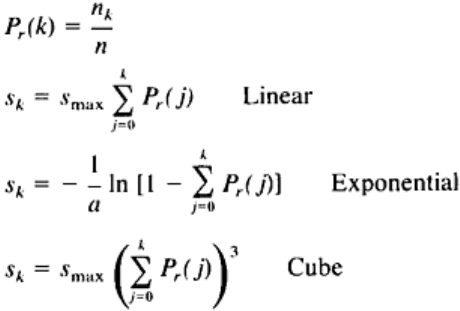
(Eq 2)
A simple linear equalization example is shown in Fig. 3(b). Occasionally, it may be desirable to use the cubic or
logarithmic equalization. The cubic emphasizes the lower values, making the image darker, while the exponential makes
the image much brighter. Other types of transfer functions are often used to remove nonlinear response in the imaging or
camera system. For isolated defects, a manual stretch usually gives good results. On textured materials, however,
histogram equalization often works well. An example of a linear histogram equalization of a low-contrast ultrasonic
image of a bond line in an explosively bonded steel-to-aluminum plate is shown in Fig. 2 in the article "Use of Color for
NDE" in this Volume.
Contouring and Thresholding. Contouring and thresholding are often combined with palette operations to show
gradations in intensity or to highlight defects. Color should be used to detect gradients in intensity because the eye is
sensitive to many more colors (approximately 10
4
shades) than gray levels. Thresholding can be done with a binary
picture (black and white), a color scale, or a combination of gray and color. The concept of thresholding has particular
application in the generation of a mask for future image-processing operations or the removal of the background.
Contouring is used to change only those values between two pixel levels to a certain value. It can also be used in outlining
high-definition features before further processing.
Composite Image Building. The ability to display composite images is useful in comparing the difference between
images produced by different modalities, such as a radiograph and an ultrasonic or NMR image. Because image quality
suffers greatly when displayed at resolutions of less than 512
2
it is imperative to have at least a 1024
2
display or to use
two monitors if detailed comparisons are to be made. Figure 4 illustrates how x-ray radiographs and neutron radiographs
can be displayed together and combined to enhance voids in a composite material. As shown in Fig. 4(c), the images have
simply been added to enhance the detection of voids. The absorption of neutrons in the epoxy is higher than in the
alumina and the reverse is true for the absorption of x-rays. However, the voids do not absorb in either case, and the
contrast is therefore improved if the images are added.
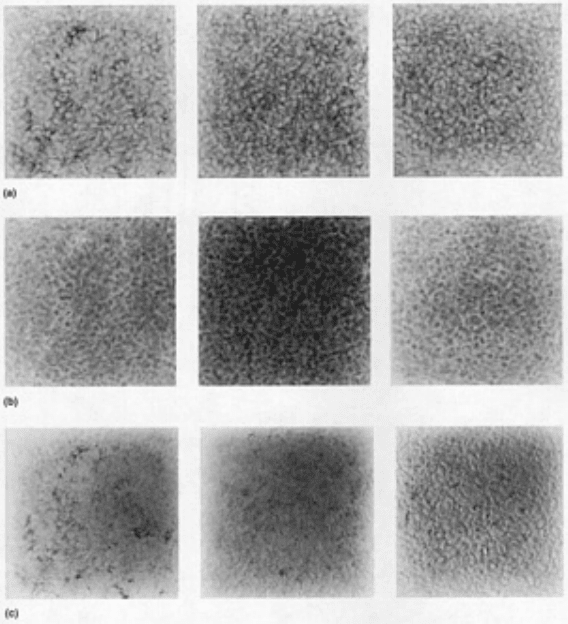
Fig. 4 Voids detected in three 60 × 60 × 10 mm (2.4 × 2.4 × 1 in.) alumina-
filled epoxy tiles using three
different imaging techniques. (a) Conventional radiography. (b) Neutron radiography. (c) Combined x-
ray and
neutr
on radiographic image. Building a composite image of both modalities indicates that there are voids in the
sample. The addition of the two images enhances the voids because of the differential absorption in the matrix
between the x-ray and neutron images.
Palette Control. Color can be displayed as a true color map or as a pseudocolor representation. In a pseudocolor
representation, the digital data values are mapped to any color that can be produced by the combination of the red, green,
and blue (RGB) values specified by a look-up table (LUT). A typical 8-bit pseudocolor system is shown in Fig. 5(a). With
only an 8-bit-deep pixel as shown in Fig. 2, a type of true color is possible; however, each color is represented only by
eight or fewer color levels (Fig. 5b). With 8-bits per color (as in Fig. 5c), the colors can be shaded continuously and are
suitable for three-dimensional displays in which depth cueing is indicated by decreasing the luminance. Eight-bit pixels
with 24-bit LUTs can produce good color scenes by adjusting the LUT to include only those colors that appear in a scene.
However, the palette is then image specific.
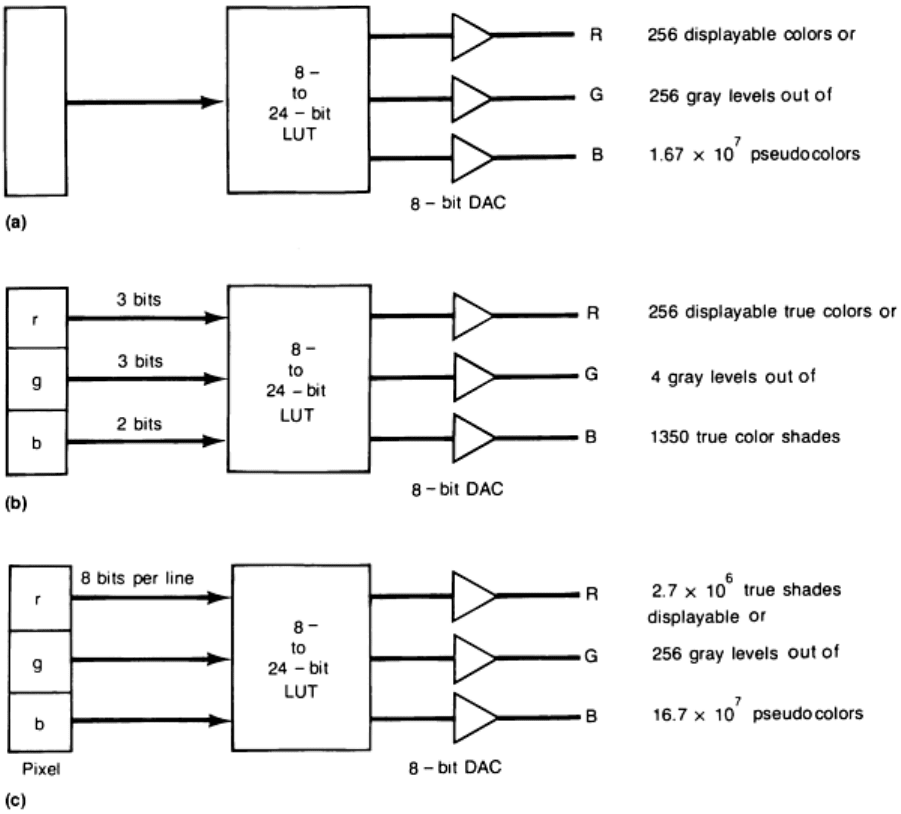
Fig. 5 Concept of a look-up table for three types of color displays. (a) 8-bit pseudocolor representation. (b) 8-
bit true color map. (c) 24-bit true color map. The LUT is controlled by the palette, which specifies what color
composition (R,G,B) will be assigned to one of 256 levels, as in (a). The digital-to-
analog converter (DAC)
converts the digital signal to RGB for input to the monitor. Shown in (b) is a way to display true color with an 8-
bit pixel. Better true color can be obtained by using a 24-
bit pixel, with each byte (8 bits) assigned to a specific
primary color, as in (c).
Several types of pseudocolor and linear gray-scale palettes are shown in Fig. 4 in the article "Use of Color for NDE" in
this Volume. The spectrum palette (or inverse spectrum) is preferred for range of color, but is not suitable for displaying
rapid changes in pixel level. Other palettes, such as the complementary palettes shown in Fig. 4(d) and (e), can be used
with good results on figures that have gradual changes in gray level. A typical threshold palette is shown in Fig. 4(b). All
values below 192 will appear as a gray scale, while those equal to or above 192 will appear as red. The gray scale is still
used to display lower-intensity data so that the operator can still detect unusual, yet not rejectable, anomalies. In contrast
stretching, when further work on the image is anticipated, the palette (that is, LUT values) is altered, leaving the pixel
values intact.
Color Models and the Use of Color. There are two main color models: the red, green, blue (RGB) model and the
hue, saturation, luminance (HSL) model. High-resolution imaging systems use the RGB model, while the National
Television Systems Committee has adopted the HSL model for broadcast television. The colors in the RGB model are
simply an additive mixture of the Commission Internationale de l'Éclairage monochromatic primary colors (red = 700 nm,
or 7000 Å; green = 546.1 nm, or 5461 Å; and blue = 435.8 nm, or 4358 Å). When equal intensities of these colors are
combined, a nearly white light results. In the HSL model, the primaries are transformed such that the hue value represents
the color (0 to 360°; red = 0, 360; green = 120; and blue = 240), the saturation is the color intensity (values 0 to 1), and
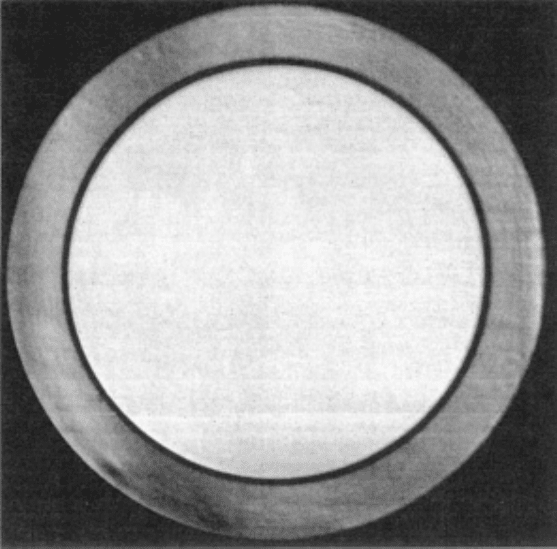
the luminance is the amount of brightness (0 to 1). If the saturation is 0 and the luminance is 1, the color will be white.
The advantage of the HSL model is that a single hue can be manipulated in intensity more easily than with the RGB
model.
Although both color and black-and-white images contain the same information, there are features that are much more
obvious in color plots than in corresponding black-and-white plots, and vice versa. In particular, a black-and-white
representation is appropriate when there is a high spatial frequency inherent in the image; in such a case, the mind-eye
combination interprets this as a texture. On the other hand, color is preferred when there are a few isolated objects or low
spatial frequency. This makes it easier for the image interpreter to discern small changes in image density through the use
of contrast enhancement. Black-and-white images are shown in Fig. 6 and 7, and the color versions are shown in Fig. 6(c)
and (d) in the article "Use of Color for NDE" in this Volume.
Fig. 6 Ultrasonic image of a hot isostatic pressed tungsten
plate prepared from powder (99% dense). The
black-and-
white image shows small changes in density that are not easily discernible. The density changes are
enhanced by the use of color, as shown in Fig. 6(c) of the article "Use of Color for NDE"
in this Volume. The ring
is caused by a transition from one thickness to another (the outer thickness was about 50% of the inner circle).
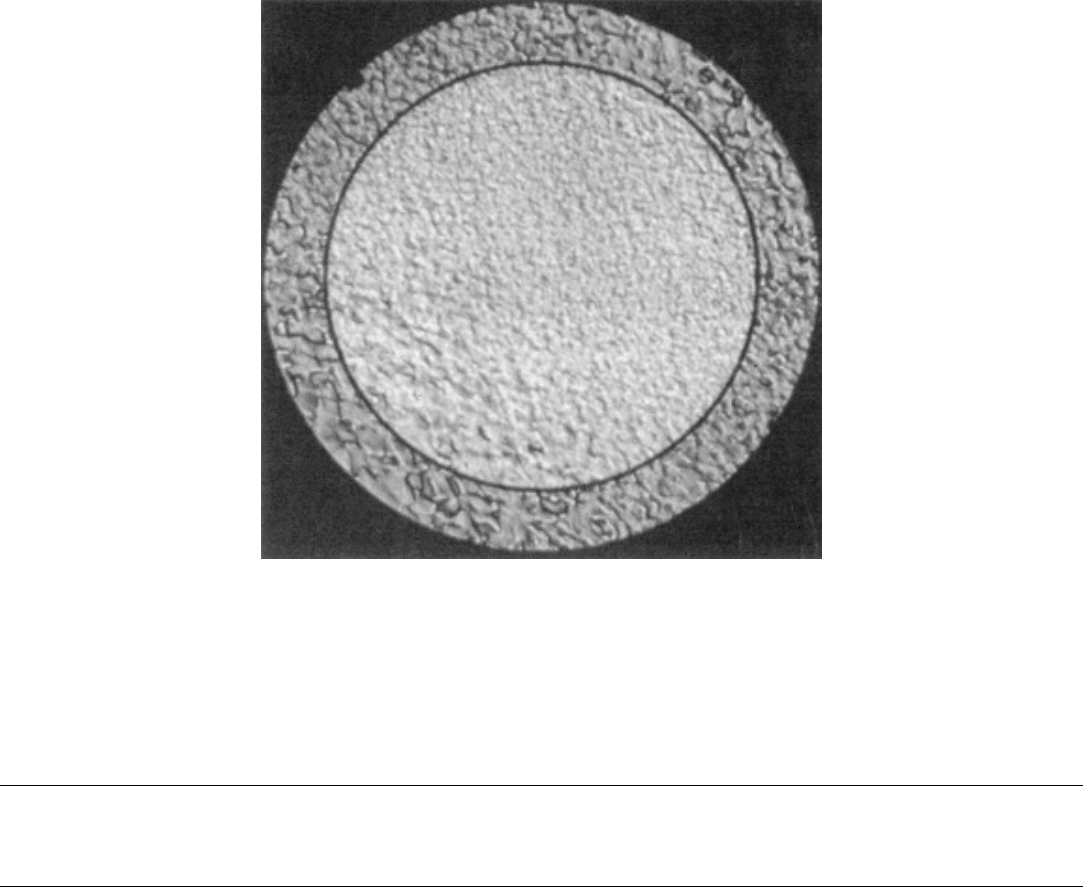
Fig. 7 Tungsten plate similar to the one shown in Fig. 6
, except that this part was fabricated from a plate that
was rolled rather than hot isostatic pressed. The black-and-
white image shows a texture imparted to the
material due to the inclusion of 2% porosity. The color version of the plate, Fig. 6(d) in the article
"Use of Color
for NDE" in t
his Volume, shows how difficult the texture is to interpret in a color representation using a
spectrum palette.
Digital Image Enhancement
T.N. Claytor and M.H. Jones, Los Alamos National Laboratory
Image Operations
Listed in the second column of Table 3 are some of the more important image operations that are routinely used to
manipulate images.
Geometric Processes. The scaling, rotation, translation, warping, and registration of an image are classified as
geometric processes.
The scaling of an image is an important function because it is often used before images are combined. Scaling is used to
magnify or shrink the images permanently to fit printer sizes or simply to view areas closely.
Rotation and translation are important mainly if two images need to be registered closely and combined or
compared. The operations are described below. The scaling operation can involve interpolation, or it can merely involve a
duplication of pixels. In the case of integer scaling (×2, ×3), the pixels are replicated in the x and y by the integer. For
noninteger scaling (such as magnification by 1.5), every other pixel is replicated. Image interpolation and noninteger
scaling should be avoided unless the image is subsequently filtered or unless interpolation and scaling are the last steps in
a processing chain before printing. The printer will often perform interpolation and dithering (adding a small random
number to the value) to obtain an image with a smoother appearance:
